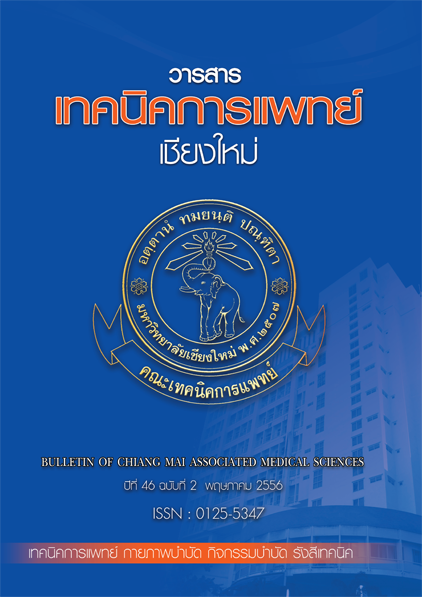Trunk Displacement during the Sit-to-Stand Tests in Young Adults
Main Article Content
Abstract
Objective: The purpose of this study was to compare trunk displacements during the two-leg and one-leg sit-to-stand (STS) test and to examine the relationship between variable obtained from the STS test (power STS) and maximum voluntary contraction of the knee extensor muscle (MVC)
Materials and Methods: Forty four young adults (22 males and 22 females; mean age 21.0±1.6 years) participated in the study. All participants completed both the two-leg and one-leg STS tests to measure time and power of the STS tests. Knee extensor MVC was measured by a force sensor. Pearson product moment correlation coefficient statistics was used to determine the relationship between variables obtained from the STS tests and knee extensor MVC. Paired sample t-test was used to determine differences in the trunk displacements between the two STS tests. A significant level was set at p≤0.05.
Results: The trunk displacements in anteroposterior and mediolateral directions for the one-leg STS test were significantly greater than those of the two-leg STS test (p<0.001). The trunk displacement in vertical direction did not differ between the two STS tests. There were significant positive correlations between MVC and power of both the two-leg and one-leg STS (p<0.001). The relationship between the power of the one-leg STS and knee extensor MVC was found to be very high (R Power-MVC = 0.832, p<0.001).
Discussion and Conclusions: The one-leg STS movement was performed using only muscle force from one leg to initiate the forward and upward movement of the whole body. Therefore, larger forward displacement of the trunk was needed to accomplish this task, resulting in greater forward momentum of the upper body. Larger mediolateral displacement of the trunk while standing up with one leg represented body compensation for the reduced base of support and contributed to stabilization of the trunk which considered normal movement adjustment strategy. The power index obtained from the one-leg STS test was validated to be a better variable for evaluation of the knee extensor muscle strength than the power of the two-leg STS test in young adults. Bull Chiang Mai Assoc Med Sci 2013; 46(2):131-140
Article Details
Personal views expressed by the contributors in their articles are not necessarily those of the Journal of Associated Medical Sciences, Faculty of Associated Medical Sciences, Chiang Mai University.


